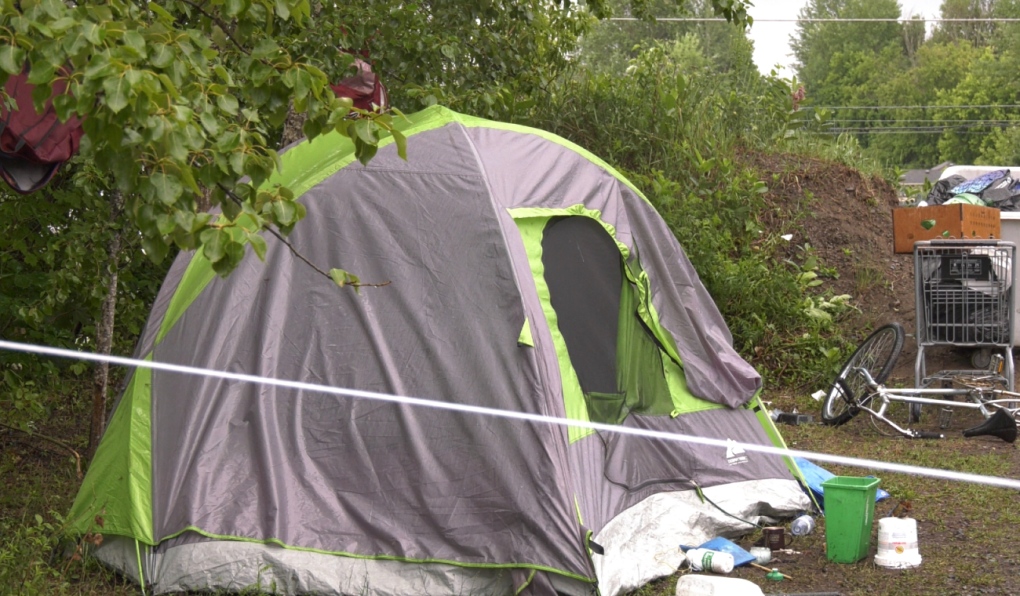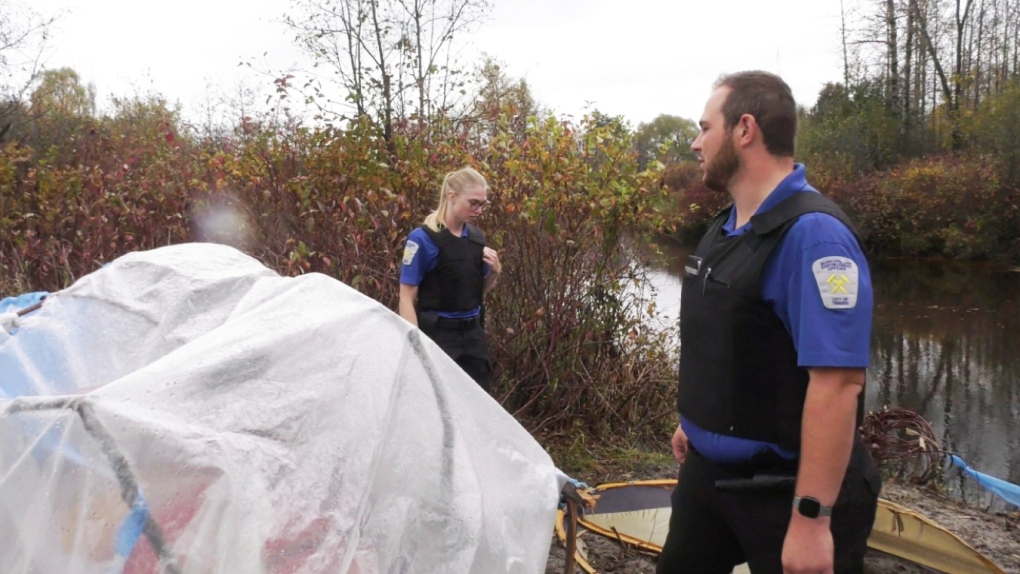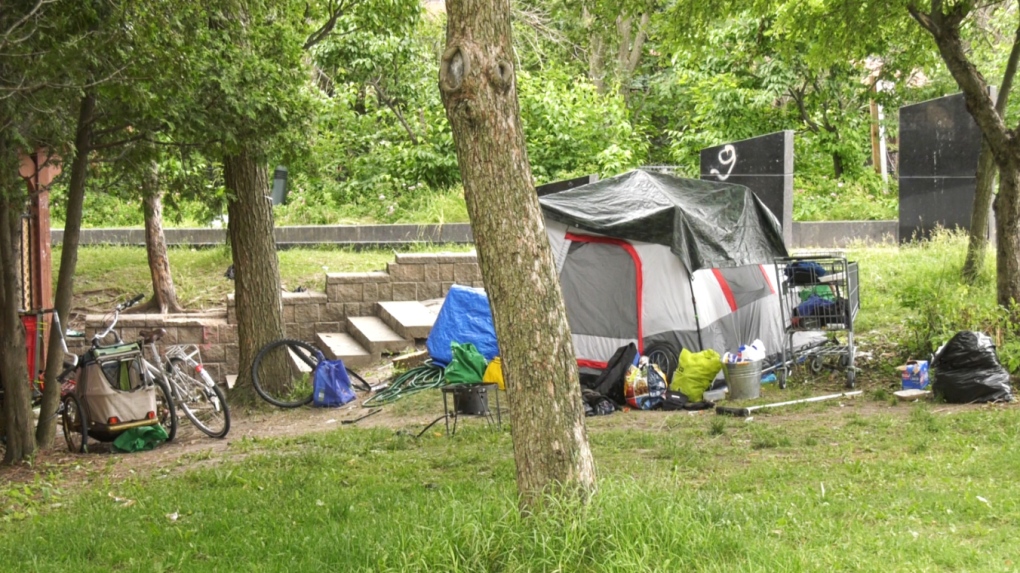Cities can’t clear encampments, don’t have resources to solve problem, report to Sault council says
A report by an Ontario municipal group says cities are bearing the brunt of the homeless crisis, but don’t have the legal or financial means to deal with the problem.
The report from the Association of Municipalities of Ontario (AMO) will be reviewed by Sault Ste. Marie city council this evening.
It focuses on the modern phenomenon of homeless encampments, which have sprung up in cities across Canada, including northern Ontario, since the COVID-19 pandemic.
“Municipal governments are at the front lines of the homelessness crisis without the resources or tools to support our residents and communities,” the report said.
“We are asking the provincial and federal governments to work collaboratively with each other and municipalities. These are complex issues that require comprehensive responses from all orders of government working together.”
As of 2023, there are at least 1,400 homeless encampments communities across the province.
 An undated photo of a tent at a homeless encampment in the North Bay area. (Eric Taschner/CTV News Northern Ontario)
An undated photo of a tent at a homeless encampment in the North Bay area. (Eric Taschner/CTV News Northern Ontario)
“Their existence is not unique to large urban centres and can now be found in all types of communities including urban, small town, rural, and northern Ontario,” the AMO report said.
“Municipalities are often caught balancing the important needs of unsheltered people living in encampments, who deserve to be treated with empathy and respect, and a responsibility to ensure our communities are safe and vibrant places for all residents.”
It accuses the provincial and federal governments of an “abdication of leadership” as citizen groups and municipalities head to court looking for guidance on what to do.
One of the major challenges is that while courts have ruled that people can’t be forcefully removed from encampments without being offered alternative housing first, the encampments are often in public areas and can present safety hazards.
Risks to homeless and the community
“Homeless encampments are mostly unplanned environments without the infrastructure and amenities to make them healthy and safe places for the inhabitants residing there,” the report said.
“As a result, the proliferation of homeless encampments can result in substantial risks to both encampment residents and the broader community.”
The report also cites a number of case studies detailing different approaches cities have taken. One unnamed community was facing a problem with an encampment that presented “health and safety risks resulting from fires, pests, unsanitary conditions and serious criminal activity and unsanitary conditions,” the report said.
“A supervised transitional housing site was established on municipal land with 50 cabins to provide temporary shelter. On-site services help residents meet basic needs, connect to services and permanent housing options.”
 A Timmins city councillor says the city has a ‘humane’ bylaw when it comes to asking people to take down their encampments. (File photo by Sergio Arangio)
A Timmins city councillor says the city has a ‘humane’ bylaw when it comes to asking people to take down their encampments. (File photo by Sergio Arangio)
But most communities don’t have the resources to offer a similar solution. And in many cases, residents refuse to leave the encampment, even when presented with options.
As municipalities struggle to find answers, residents are getting angry, the report said.
“Almost five years out from the beginning of the pandemic, many municipalities with long-term encampments are experiencing an erosion of community will, trust and buy-in for solutions,” the report said.
Increasing tension, lack of consensus
“Tensions arise between individual and community obligations when municipalities respond to encampments. There is often a lack of consensus between what encampment residents need, what community members want, what human rights advocates are calling for, and what municipalities believe they must do to fulfill their roles and responsibilities to all residents.”
Communities such as Sudbury, which managed to clear a large encampment in Memorial Park, hired a consultant to help deal with the issue, but the encampments persist.
Many cities are faced with the possibility of having to live with them long-term.
But “it is not a sustainable, long-term solution for municipalities to allow the normalization of encampments,” the report said.
 A beautiful garden in downtown Sudbury is no longer a safe haven for residents living in the Ukrainian Seniors Centre because of what’s located on the other side of the fence: a growing homeless encampment. (Lyndsay Aelick/CTV news)
A beautiful garden in downtown Sudbury is no longer a safe haven for residents living in the Ukrainian Seniors Centre because of what’s located on the other side of the fence: a growing homeless encampment. (Lyndsay Aelick/CTV news)
“Municipalities need to act in the best interests of the homeless and their communities to find other solutions.”
Added to the problem is the mental health and drug crisis gripping the province, along with skyrocketing housing costs that have 45 per cent of Ontarians spending one-third of their total income on housing.
“Approximately 30-35 per cent of those experiencing homelessness and up to 75 per cent of women experiencing homelessness struggle with mental illnesses,” the report said.
“Inconsistent access to mental health and addictions services across the province results in gaps for many rural and northern communities that prevent progress on homelessness.”
- Download our app to get local alerts on your device
- Get the latest local updates right to your inbox
The report calls on the province to expand the emergency shelter system, establish a province-wide guidance policy on dealing with encampments and match the $250 million the federal government has announced to help communities deal with encampments.
And it called on the federal government to provide an additional $3.5 billion a year – seven times more than the current amount – to reach its goal of reducing homelessness by 50 per cent.
The report also emphasizes that “individuals do not have a right to camp anywhere they choose on public lands, at any time. Nor do those who decline appropriate alternative shelter options have a right to continue to reside in encampments.”
“Encampments located in major parks that are heavily accessed by the public are different from encampments located on empty lots,” the report said.
“The degree to which the presence of an encampment impedes public use of space may be a relevant factor, particularly from a public safety perspective.”
Read the full report here, beginning on page 189.
CTVNews.ca Top Stories

Multiple Jewish organizations, hospitals across Canada receive identical bomb threats
Police in multiple cities across Canada are responding to bomb threats that were sent to Jewish organizations, synagogues and some hospitals this morning.
BREAKING 'Intimate partner violence' led to triple homicide in McCreary: Manitoba RCMP
A 'horrific act of intimate partner violence' is what led to a triple homicide in McCreary, Man. last week according to RCMP.
Tory MP deletes post that claimed cost of living is driving parents to traffic kids
Conservative MP Michelle Ferreri has deleted a post on X that claimed the affordability crisis has driven parents to traffic their kids.
Global Affairs Canada 'very proud' of $9M NYC condo purchase, says consul general Tom Clark didn't influence
Canada's consul general in New York Tom Clark did not influence the government's decision to purchase his new official residence, a senior Global Affairs Canada official told MPs Wednesday.
'Caught me by surprise': Rare 'blue' frog spotted in Nova Scotia
When a Nova Scotia woman set out on a walk, she ended up discovering something very colourful - a rare 'blue' frog.
Boaters urged to seek shelter as 'waterspout watch' issued for coastal B.C.
Environment Canada has issued a waterspout watch for British Columbia's South Coast, urging mariners to prepare for the potentially dangerous weather phenomena.
Alicia Silverstone is 'alive and well' after concern over her possibly poisonous snack
'Clueless' star Alicia Silverstone sparked concern after she posted a video in which she took a bite into what some of her followers speculated was poisonous fruit.
Commuters, billions of dollars could be affected by rail strike; Trudeau urges deal
Prime Minister Justin Trudeau is urging negotiators to reach a deal to prevent an unprecedented railway stoppage that could have an economic impact worth billions of dollars.
2 found in trunk of car speeding 50 km/h over the limit in Ottawa
Ottawa police caught a group of eight people in a five-seater vehicle speeding 50 km/h over the speed limit on Greenbank Road in Ottawa's Barrhaven neighbourhood.


































